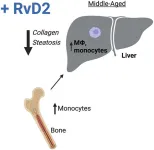(Press-News.org) A central goal in quantum optics and photonics is to increase the strength of the interaction between light and matter to produce, e.g., better photodetectors or quantum light sources. The best way to do that is to use optical resonators that store light for a long time, making it interact more strongly with matter. If the resonator is also very small, such that light is squeezed into a tiny region of space, the interaction is enhanced even further. The ideal resonator would store light for a long time in a region at the size of a single atom.
Physicists and engineers have struggled for decades with how small optical resonators can be made without making them very lossy, which is equivalent to asking how small you can make a semiconductor device. The semiconductor industry’s roadmap for the next 15 years predicts that the smallest possible width of a semiconductor structure will be no less than 8 nm, which is several tens of atoms wide.
The team behind a new paper in Nature, Associate Professor Søren Stobbe and his colleagues at DTU Electro demonstrated 8 nm cavities last year, but now they propose and demonstrate a novel approach to fabricate a self-assembling cavity with an air void at the scale of a few atoms. Their paper’ Self-assembled photonic cavities with atomic-scale confinement’ detailing the results is published today in Nature [LINK].
To briefly explain the experiment, two halves of silicon structures are suspended on springs, although in the first step, the silicon device is firmly attached to a layer of glass. The devices are made by conventional semiconductor technology, so the two halves are a few tens of nanometers apart. Upon selective etching of the glass, the structure is released and now only suspended by the springs, and because the two halves are fabricated so close to each other, they attract due to surface forces. By carefully engineering the design of the silicon structures, the result is a self-assembled resonator with bowtie-shaped gaps at the atomic scale surrounded by silicon mirrors.
“We are far from a circuit that builds itself completely. But we have succeeded in converging two approaches that have been travelling along parallel tracks so far. And it allowed us to build a silicon resonator with unprecedented miniaturization,” says Søren Stobbe.
Two separate approaches
One approach – the top-down approach – is behind the spectacular development we have seen with silicon-based semiconductor technologies. Here, crudely put, you go from a silicon block and work on making nanostructures from them. The other approach – the bottom-up approach – is where you try to have a nanotechnological system assemble itself. It aims to mimic biological systems, such as plants or animals, built through biological or chemical processes. These two approaches are at the very core of what defines nanotechnology. But the problem is that these two approaches were so far disconnected: Semiconductors are scalable but cannot reach the atomic scale, and while self-assembled structures have long been operating at atomic scales, they offer no architecture for the interconnects to the external world.
“The interesting thing would be if we could produce an electronic circuit that built itself—just like what happens with humans as they grow but with inorganic semiconductor materials. That would be true hierarchical self-assembly. We use the new self-assembly concept for photonic resonators, which may be used in electronics, nanorobotics, sensors, quantum technologies, and much more. Then, we would really be able to harvest the full potential of nanotechnology. The research community is many breakthroughs away from realizing that vision, but I hope we have taken the first steps,” says Guillermo Arregui, who co-supervised the project.
Approaches converging
Supposing a combination of the two approaches is possible, the team at DTU Electro set out to create nanostructures that surpass the limits of conventional lithography and etching despite using nothing more than conventional lithography and etching. Their idea was to use two surface forces, namely the Casimir force for attracting the two halves and the van der Waals force for making them stick together. These two forces are rooted in the same underlying effect: quantum fluctuations (see Fact box).
The researchers made photonic cavities that confine photons to air gaps so small that determining their exact size was impossible, even with a transmission electron microscope. But the smallest they built are of a size of 1-3 silicon atoms.
“Even if the self-assembly takes care of reaching these extreme dimensions, the requirements for the nanofabrication are no less extreme. For example, structural imperfections are typically on the scale of several nanometers. Still, if there are defects at this scale, the two halves will only meet and touch at the three largest defects. We are really pushing the limits here, even though we make our devices in one of the very best university cleanrooms in the world,” says Ali Nawaz Babar, a PhD student at the NanoPhoton Center of Excellence at DTU Electro and first author of the new paper.
“The advantage of self-assembly is that you can make tiny things. You can build unique materials with amazing properties. But today, you can’t use it for anything you plug into a power outlet. You can’t connect it to the rest of the world. So, you need all the usual semiconductor technology for making the wires or waveguides to connect whatever you have self-assembled to the external world.”
Robust and accurate self-assembly
The paper shows a possible way to link the two nanotechnology approaches by employing a new generation of fabrication technology that combines the atomic dimensions enabled by self-assembly with the scalability of semiconductors fabricated with conventional methods.
“We don’t have to go in and find these cavities afterwards and insert them into another chip architecture. That would also be impossible because of the tiny size. In other words, we are building something on the scale of an atom already inserted in a macroscopic circuit. We are very excited about this new line of research, and plenty of work is ahead,” says Søren Stobbe.
-
FACT BOX: Surface forces
There are four known fundamental forces: Gravitational, electromagnetic, and strong and weak nuclear forces. Besides the forces due to static configurations, e.g., the attractive electromagnetic force between positively and negatively charged particles, there can also be forces due to fluctuations. Such fluctuations may be either thermal or quantum in origin, and they give rise to surface forces such as the van der Waals force [LINK: Van der Waals force - Wikipedia] and the Casimir force [LINK: Casimir effect - Wikipedia], which act at different length scales but are rooted in the same underlying physics. Other mechanisms, such as electrostatic surface charges, can add to the net surface force. For example, geckos exploit surface forces to cling to walls and ceilings.
-
FACT BOX: How it was done
The paper details three experiments that the researchers carried out in the labs at DTU:
No fewer than 2688 devices across two microchips were fabricated, each containing a platform that would either collapse onto a nearby silicon wall – or not collapse, depending upon the surface area details, spring constant, and distance between platform and wall. This allowed the researchers to make a map of which parameters would – and would not – lead to deterministic self-assembly. Only 11 devices failed due to fabrication errors or other defects, a remarkably low number for a novel self-assembly process.
The researchers made self-assembled optical resonators whose optical properties were verified experimentally, and the atomic scale was confirmed by transmission electron microscopy.
The self-assembled cavities were embedded in a larger architecture consisting of self-assembled waveguides, springs, and photonic couplers to make the surrounding microchip circuitry in the same process. END
Bowtie resonators that build themselves bridge the gap between nanoscopic and macroscopic
In a new Nature paper, two nanotechnology approaches converge by employing a new generation of fabrication technology. It combines the scalability of semiconductor technology with the atomic dimensions enabled by self-assembly.
2023-12-06
ELSE PRESS RELEASES FROM THIS DATE:
Embargoed press release: Blood hormone levels key to identifying which post-menopausal women will benefit most from taking anastrozole to prevent breast cancer
2023-12-06
Research led by Queen Mary University of London’s Wolfson Institute of Population Health has found that hormone levels, measured through blood tests, are an important indicator of whether women will benefit from recently licensed medication for the prevention of breast cancer.
Aromatase inhibitors such as anastrozole are recommended by the National Institute of Clinical Care and Excellence (NICE) as an option for preventive therapy in post-menopausal women at high risk of breast cancer. Anastrozole (Arimidex) is now also licensed by the ...
MD Anderson Research Highlights: ASH 2023 Special Edition
2023-12-06
ABSTRACTS: 162, 309, 322, 364, 741, 774, 856, 983
SAN DIEGO ― The University of Texas MD Anderson Cancer Center’s Research Highlights showcases the latest breakthroughs in cancer care, research and prevention. These advances are made possible through seamless collaboration between MD Anderson’s world-leading clinicians and scientists, bringing discoveries from the lab to the clinic and back.
This special edition features oral presentations from the 2023 American Society of Hematology (ASH) Annual Meeting, describing the latest scientific and clinical breakthroughs for hematological cancers. In addition to these ...
EHR-based public health surveillance for chronic diseases
2023-12-06
INDIANAPOLIS – As hospitalizations due to chronic conditions increase across the United States, attention is focusing on using data collected in electronic health records (EHRs) by healthcare systems to enable public health departments to gain understanding of the incidence and prevalence of hypertension, diabetes, asthma, obesity and other chronic diseases with the ultimate goal of improving disease outcomes.
In the U.S., 90 percent of clinicians, medical laboratories, imaging centers and other providers use EHR systems, providing ample data on individuals with access to healthcare. However, access ...
Tucatinib plus trastuzumab emtansine may benefit patients with advanced or metastatic HER2-positive breast cancer
2023-12-06
SAN ANTONIO – A combination of two HER2-targeted drugs, tucatinib (Tukysa) and trastuzumab emtansine (Kadcyla, T-DM1), extended progression-free survival among patients with unresectable locally advanced or metastatic HER2-positive breast cancer, compared with T-DM1 alone, according to results from the HER2CLIMB-02 trial presented at the San Antonio Breast Cancer Symposium, held December 5-9, 2023.
T-DM1 is an antibody-drug conjugate comprised of trastuzumab (Herceptin) and the cytotoxic drug emtansine. It was approved for use ...
Neoadjuvant chemotherapy may help some breast cancer patients skip regional nodal irradiation
2023-12-06
SAN ANTONIO – For patients whose breast cancer converted from lymph node-positive to lymph node-negative disease after neoadjuvant chemotherapy, skipping adjuvant regional nodal irradiation (RNI) did not increase the risk of disease recurrence or death five years after surgery, according to results from the NRG Oncology/NSABP B-51/RTOG 1304 clinical trial presented at the San Antonio Breast Cancer Symposium, held December 5-9, 2023.
Patients who are diagnosed with breast cancer that has already spread to regional lymph nodes may receive neoadjuvant chemotherapy; in some cases, neoadjuvant therapy completely eradicates ...
Study: diverse college classrooms linked to better STEM learning outcomes for all students
2023-12-06
Washington, December 6, 2023—Students achieve better grades in college science, technology, engineering, and math (STEM) courses when those classrooms have higher numbers of underrepresented racial-minority and first-generation college students, according to new research released today. The findings were published in AERA Open, a peer-reviewed journal of the American Educational Research Association.
While this link holds true for all students, it is even stronger for students who are underrepresented racial minorities (URMs) and the first in their family to attend college. The authors found that in STEM courses ...
Repeated blast exposures may harm the brain health of military personnel
2023-12-06
The brains of special warfare community personnel repeatedly exposed to blasts show increased inflammation and structural changes compared with a control group, potentially increasing the risk of long-term, brain-related disease, according to a new study.
Researchers from the University of Virginia School of Medicine and Naval Medical Research Command (NMRC) led the study, which compared the brains of nine special operations personnel exposed to blasts with a control group of nine military service members with only minimal exposures to blasts. Participants’ brains were analyzed using sophisticated imaging techniques, combined with surveys ...
New findings reveal important insights into age-related nonresolving inflammation
2023-12-06
Philadelphia, December 6, 2023 – Aging is associated with chronic, nonresolving inflammation, or “inflammaging,” that can lead to tissue dysfunction. New findings reported in The American Journal of Pathology, published by Elsevier, reveal insights into the cellular programs and factors that promote the resolution of inflammation during aging. These findings may lead to the development of new strategies to limit age-related organ decline.
The resolution of inflammation is an active process that is governed by numerous factors, such as specialized ...
JAMA Editor in Chief Dr. Kirsten Bibbins-Domingo named one of Modern Healthcare’s 100 Most Influential of 2023
2023-12-06
Kirsten Bibbins-Domingo, Ph.D., M.D., M.A.S.., Editor in Chief of the Journal of the American Medical Association (JAMA) and the JAMA Network™ has been named as one of Modern Healthcare’s 100 Most Influential People in Healthcare 2023 for the second year in a row.
This program acknowledges and honors individuals who are deemed by their peers and the senior editors of Modern Healthcare to be the most influential figures in the industry in terms of leadership and impact.
"It’s an honor to be recognized for two consecutive years by Modern Healthcare," ...
Model uses sociodemographic factors to predict aromatase inhibitor non-adherence risk
2023-12-06
A new risk model uses baseline sociodemographic and financial measures to predict which patients prescribed long-term therapy with aromatase inhibitors for breast cancer are at significantly higher risk of stopping that therapy early (non-adherence).
The work will be presented in a poster spotlight discussion session at the 2023 San Antonio Breast Cancer Symposium (SABCS) on Wednesday, December 6th.
The authors analyzed data from the SWOG S1105 clinical trial, including measures of patient adherence to aromatase inhibitor (AI) therapy for hormone-sensitive breast cancer. They created a model ...
LAST 30 PRESS RELEASES:
Survey reveals ethical gaps slowing AI adoption in pediatric surgery
Stimulant ADHD medications work differently than thought
AI overestimates how smart people are, according to HSE economists
HSE researchers create genome-wide map of quadruplexes
Scientists boost cell "powerhouses" to burn more calories
Automatic label checking: The missing step in making reliable medical AI
Low daily alcohol intake linked to 50% heightened mouth cancer risk in India
American Meteorological Society announces Rick Spinrad as 2026 President-Elect
Biomass-based carbon capture spotlighted in newly released global climate webinar recording
Illuminating invisible nano pollutants: advanced bioimaging tracks the full journey of emerging nanoscale contaminants in living systems
How does age affect recovery from spinal cord injury?
Novel AI tool offers prognosis for patients with head and neck cancer
Fathers’ microplastic exposure tied to their children’s metabolic problems
Research validates laboratory model for studying high-grade serous ovarian cancer
SIR 2026 delivers transformative breakthroughs in minimally invasive medicine to improve patient care
Stem Cell Reports most downloaded papers of 2025 highlight the breadth and impact of stem cell research
Oxford-led study estimates NHS spends around 3% of its primary and secondary care budget on the health impacts of heat and cold in England
A researcher’s long quest leads to a smart composite breakthrough
Urban wild bees act as “microbial sensors” of city health.
New study finds where you live affects recovery after a hip fracture
Forecasting the impact of fully automated vehicle adoption on US road traffic injuries
Alcohol-related hospitalizations from 2016 to 2022
Semaglutide and hospitalizations in patients with obesity and established cardiovascular disease
Researchers ‘listen in’ to embryo-mother interactions during implantation using a culture system replicating the womb lining
How changing your diet could help save the world
How to make AI truly scalable and reliable for real-time traffic assignment?
Beyond fragmented markets: A new framework for efficient and stable ride-pooling
Can shape priors make road perception more reliable for autonomous driving?
AI tracks nearly 100 years of aging research, revealing key trends and gaps
Innovative techniques enable Italy’s first imaging of individual trapped atoms
[Press-News.org] Bowtie resonators that build themselves bridge the gap between nanoscopic and macroscopicIn a new Nature paper, two nanotechnology approaches converge by employing a new generation of fabrication technology. It combines the scalability of semiconductor technology with the atomic dimensions enabled by self-assembly.





